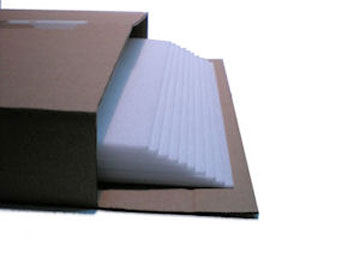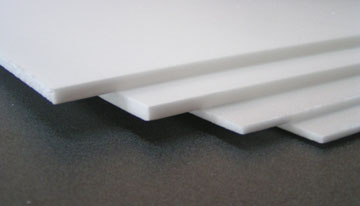- rcfoam -- EPP 1.3#, EPP 1.9#, Deppron, XPS, carbon and other materials.
- Dollar Tree -- 36x24 6mm sheets from Adams, with paper.
- Model Plane Foam -- top quality Adams foam, without paper.
Types of Foam
Here's a summary of various types of foam used in RC modeling. I'm no expert in this area, so let me know of any inaccuracies. Thanks to TP16 and RogueTitan on rcgroups for some of the material below. This is a work in progress. If you have more information or more types of foam leave a comment below!
First, a few definitions:
Expanded foam is melted and injected into a mold.
Extruded foam is cast as large blocks and cut into sheets. In real life this foam is often used as building insulation.
Polystyrene, Polypropylene, etc, are different types of materials with different characteristics regarding weight, strength, flexibility, etc. Wikipedia discusses them at a level of detail far beyond my freshman chemistry class.
And the foams:
EPP a.k.a. Expanded Polypropylene.very durable sheet material, bounces well, holds up to rough treatment. Very floppy, so needs to be reinforced. comes in densities of 1.3 and 1.9 pounds per cubic foot. Typically sold in sheets up to 24x36 inches, in 3mm, 6mm, and 9mm thicknesses.
Depron. Sheet foam, very stiff but much easier to break than EPP. Easy to cut and sand, comes in white, gray, and black. Used in Europe as flooring base.
Depron Aero. even lighter than depron. Popular in competition indoor pattern flyers.
Elapor. Trade name for Multiplex's EPP foam. The Easy Star is made from this and is renowned for being a durable model.
Z Foam. From Horizon Hobby, this is a proprietary reinforced foam construction method.
Blue Core, Pink Core, etc. Extruded Polystyrene. Sold in home improvement stores in sheets of various thicknesses. The color depends on the manufacturer. Lacks beads and is generally sandable and shape-able.
Fan Fold Foam, aka FFF. The same material as Blue Cor, but in 1/4'' thick 2 feet x 50 feet sheets, fan-folded every two feet. Cheap and popular for scratch-built models. Between EPP and Depron in terms of strength and flexibility. You can see here that it's labelled as being Extruded Polystyrene.

Dollar Tree Foam Board, a.k.a. Rediboard. 3/16'' thick, 20x30 inch. Sold at Dollar Tree stores for $1 each. Official product name is ReadiBoard. Flimiser than FFF, but easier to get in warmer places where FFF is not stocked. Reinforced paper backing on both sides, people usually remove it to reduce weight. Spray with water or window cleaner, let dry, and the paper will peel off in one piece. Elmers foam board is similar but heavier.
EPP, a.k.a. Expanded PolyPropylene. This is another sort of bead foam. Generally held to be some of the most durable stuff out there, it can be flexed and twisted without snapping. Because of this, it's got very low structural integrity so airframes have to be strengthened by other means such as CF or fiberglass. Comes in a couple different densities.
EPO a.k.a. Expanded PolyOlefin. Similar to EPS but different as well. It's reportedly stronger and has a smoother, more finishable surface. Used by manufacturers such as FMS.
EPS a.k.a. Expanded PolyStyrene. This is your basic beer-cooler foam. Little white beads, various densities. Note that "EPS" is also occasionally used for Extruded PolyStyrene, which is a different material entirely. Still foam, but made by -you guessed it- extruding rather than expanding.
Daemon on RCGroups notes:
EPS is easiest to do injection molding. EPO is trickier (and varies from manufacturer to manufacturer). EPP is a real pain (requires a lot more vents in the mold, which create all those little dimples on the finished product). EPS can be the most rigid, but it's also the most brittle and hard to repair as regular CA and any solvent based glue totally dissolves it, and foam safe CA has various limitations. It's the worst around heat, so can't use iron on covering and if you crush it or bend it, it stays crushed and bent.
EPP is the least rigid per weight, but is totally bounceable, does not dent or scratch and not all that hard to stiffen up with some added stiffeners (carbon ribbons and tape). EPP is the most resistant to heat so can take any covering.
EPO is a mix of the two, so it has more rigidity per weight than EPP, and it can bend more like EPP, but still will dent or scratch. If it's a "good" EPO (Skywalker EPO, or Multiplex Elapor), it can be repaired with regular CA (creates a nice chemical bond that's stronger than the foam itself), and you can take the dents and scratches out and straighten bent or crushed foam with proper application of heat (165-170 degree water or steam). Have to be careful when applying iron on coverings (Monokote,
Ultracote, Laminating film) to not overheat the foam and puff it up.
blogodex = {"toc" : "foam", "idx" = {["suppliers", "EPS", "EPO", "Depron"]};









I like to stiffen up EPP with iron on laminate from the the copy shop. Very strong stuff.
ReplyDeleteWhat all can the EPP be used for?
ReplyDeleteWhat all can the EPP be used for?
ReplyDelete